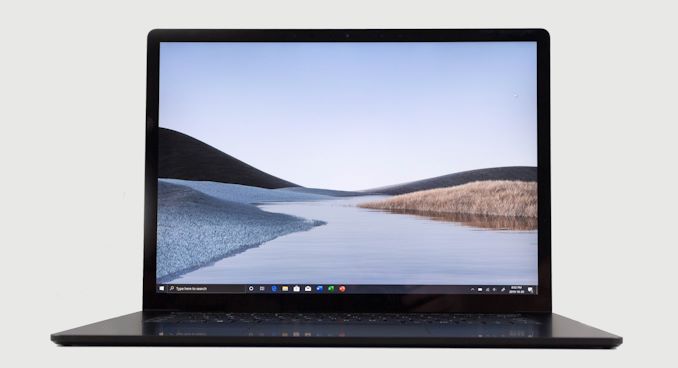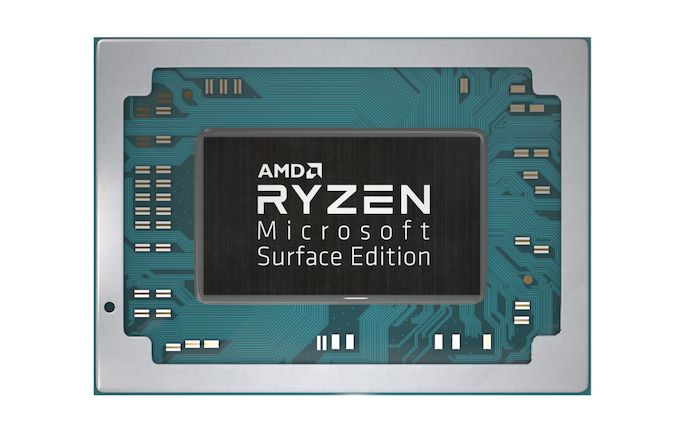The Microsoft Surface Laptop 3 Showdown: AMD's Ryzen Picasso vs. Intel's Ice Lake
by Brett Howse & Andrei Frumusanu on December 13, 2019 8:30 AM ESTFinal Words
Two laptops. Two platforms. It is rare to have a chance to see a manufacturer offer such equal footing to both AMD and Intel by outfitting a premium laptop with processors from both. It represents a rare opportunity to get to test the latest processors from AMD and Intel in a laptop in such an apples-to-apples fashion.
In the laptop space, design, cooling, and a manufacturers requirements can play a big part in how a particular chip performs, thanks to adjustable power level settings, surface temperature adjustments, and more. We have seen the lowest tier CPU outperform the highest tier CPU just by the virtue of a better cooling system, so to have processors from AMD and Intel, both of which launched in 2019, in the same chassis is a wonderful opportunity.
There aren’t too many ways to sugar coat the results of this showdown though. AMD’s Picasso platform, featuring its Zen+ cores and coupled with a Vega iGPU, has been a tremendous improvement for AMD. But Intel’s Ice Lake platform runs circles around it. Sunny Cove cores coupled with the larger Gen 11 graphics have proven to be too much to handle.
On the CPU side, no one should be too surprised by the results. We've already seen on the desktop that AMD’s Zen+ cores were competitive, but slightly slower than the previous Skylake platform; and the new Sunny Cove microarchitecture from Intel is a big step forward in terms of IPC for Intel. On purely CPU based tasks, Ice Lake really stretched its legs, and despite this being a 3.9 GHz chip, in single-threaded SPEC 2017, it managed to come very close to a 5.0 GHz Core i9-9900K with a massively higher TDP. Zen+ is outclassed here, and that showed in the benchmark results, and especially in the benchmark time. On our 8-thread SPEC 2017 run, the Ice Lake platform finished just a hair over two hours ahead of Picasso.
But things fare better for AMD on the GPU side of matters. Even though Intel has certainly closed the gap with Ice Lake's iGPU, AMD seems to continue to hold an advantage, especially on the 11 Compute Unit Ryzen Surface Edition processor found in the Surface Laptop 3. Intel has dedicated a lot more die area to the GPU and the results put them almost on equal footing with the Vega based GPU on Picasso. On the more complex GPU tasks, AMD tends to have a slight lead, and AMD’s low-level driver support also seems to benefit them on DirectX 12 based tasks. But, Ice Lake’s GPU is helped by the much quicker CPU it is coupled to, so depending on the specific test it can be even quicker.
Ice Lake does all of this with much better power efficiency as well. Overall battery life is quite a bit longer, and idle power draw is notably lower as well. Case in point: at minimum screen brightness, the Ice Lake system was pretty much only sipping power, drawing around 1.7 Watts, versus the 3.0 Watts for the AMD system.
It was fantastic to see AMD get a design win in a premium laptop this year, and the Surface Laptop 3 is going to turn a lot of heads over the next year. AMD has long needed a top-tier partner to really help its mobile efforts shine, and they now have that strong partner in Microsoft, with the two of them in a great place to make things even better for future designs. Overall AMD has made tremendous gains in their laptop chips with the Ryzen launch, but the company has been focusing more on the desktop and server space, especially with the Zen 2 launch earlier this year. For AMD, the move to Zen 2 in the laptop space can’t come soon enough, and will hopefully bring much closer power parity to Intel’s offerings as well.
Meanwhile for Intel, Ice Lake has been years in the making, and, after a long delay, it is finally here. After digging into the platform in-depth, it’s clear that Ice Lake is an incredibly strong offering from Intel. The CPU performance gains are significant, particularly because they were made in the face of a CPU frequency deficit. But the biggest gains were on the GPU side, where Intel’s Gen 11 GT2 in its full 64 Execution Unit configuration is likely the biggest single increase in GPU performance since they started integrating GPUs. It pulls very close to AMD’s Vega, closing the gap in performance to almost zero.
2019 has been a big year in the laptop space, with both Intel and AMD bringing new tools to the game. 2020 should be just as exciting, and if we’re lucky, we’ll get another chance to do this all over again.













174 Comments
View All Comments
MBarton - Monday, December 30, 2019 - link
There's a lot more money in server and retail desktop CPU's than there are in sub-$1000 mobile parts. Why would AMD send perfect good Zen 2 cores to the mobile market if they can sell them as something with better margins?Teckk - Friday, December 13, 2019 - link
There's no way to recommend an AMD laptop yet. Intel has all the numbers both in terms of performance and in terms of the various models by different OEMs. Lot to catch up for AMD. This market is Intel's to lose and by the looks of the integrated graphics in this, seems to be a tough task for AMD.5080 - Friday, December 13, 2019 - link
Zen 2 based APU's (Renoir) will easily catch up to Intel's mobile CPU lineup. We can assume that graphics and storage performance will be much better since NVMe can use the PCIe 4.0 bus and AMD's iGPU was always ahead of Intel. We will know soon since AMD is scheduled to release Renoir on CES in January. Microsoft should have waited for Renoir before putting it into its Surface.smilingcrow - Friday, December 13, 2019 - link
Looking at the current high power draw of PCIe 4.0 I can't see it being attractive for mobile just yet, especially as battery life is generally more important than 5GB/s storage speeds in laptops.GreenReaper - Friday, December 13, 2019 - link
If you can use half the lanes I can totally see it being attractive - just as a quad-core may use less power than an octa-core. The main issue on the desktop is wanting the same number of faster lanes.MBarton - Monday, December 30, 2019 - link
Exactly. AMD showing up with Zen 2 and x570's PCIe 4.0 wouldn't have carried much weight if they sacrificed lane count in the process.RSAUser - Friday, December 13, 2019 - link
It doesn't pull the full required power at all times, it's fine for burst.Still think it doesn't really make sense though as you don't need the speed in any laptops right now as no drive can properly max it.
RSAUser - Friday, December 13, 2019 - link
Storage speed is relative, most would not notice the speedup.MASSAMKULABOX - Sunday, December 15, 2019 - link
Anybody care to mak any predictions on how much better the rRenoir Igpu will be compared to the 2400/3400g .. I'm thinking maybe a 25% uplift but maybe more it its NAVI. However everyone seems to be foregtting they have done most of the work , in getting out the Head Canyon NUC for Intel. they can announce in Jan with general avail in 2,3,6 months ??scineram - Monday, December 16, 2019 - link
No.